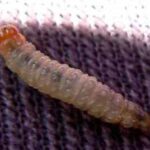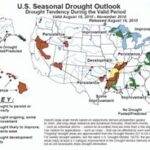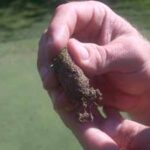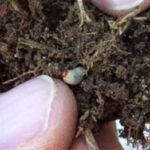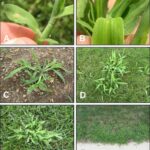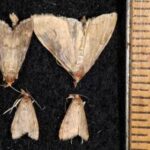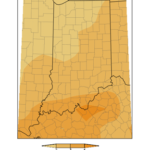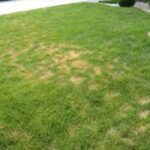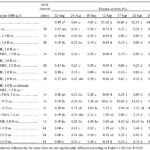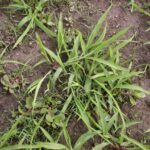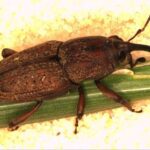Turf Professional
Late Season Insects Found in Turfgrass
The following letter and pictures were sent to us for identification. There was a buzz of follow-up letters and communication afterward indicating that maybe this is not just an isolated occurrence. I have enclosed the initial letter, accompanying photographs and the return response in hopes that this is of value to others noticing the same […]
Predicting the Future and Documenting the Past
When weather patterns are not typical, as with this summer, it is useful to both look ahead and behind to help improve your maintenance practices and better time future applications. Documenting the Past One advantage to tough summers like this is they provide an opportunity to learn. Experiencing tough summers will prepare us to better […]
Time to make the donuts… or better yet, time to cultivate!
A shallow root system in putting green bentgrass, this plant may not tolerate deep cultivation very well Surface following solid-tine cultivation procedure, notice the rootzone mixture on the surface, the point, be careful and be gentle! A Late-Summer Cultivation Checklist: Considerations for Success: What you are trying to accomplish with this practice? Organic matter/thatch removal? […]
Summer Stress
With a warm and wet summer, we are experiencing decline in some of our turf around the state due to temperatures, disease, insects, and weeds. In response, we are publishing a four part series on this topic to help turfgrass managers respond. Look forward to the following topics over the next two weeks. Part I: […]
Crabgrass
Crabgrass is running rampant this year as the hot summer and more than adequate rainfall has helped to push this beast of a weed along. Crabgrass is a warm-season annual grass meaning that it thrives under hot and moist conditions. The high rainfall during germination (late April and early May) coupled with the wet and […]
Grass Moths Everywhere
If you have walked out on your lawn recently you may have noticed hundreds of small, buff colored, moths flittering here or there as you approach. These may be alarming for both farmers as well as turfgrass managers because they; look like a common corn pest (European Corn Borer) act like a common turfgrass pest […]
Summer Stress
With a warm and wet summer, we are experiencing decline in some of our turf around the state due to temperatures, disease, insects, and weeds. In response, we are publishing a four part series on this topic to help turfgrass managers respond. Look forward to the following topics over the next two weeks. Part I: […]
Summer Stress
Summer Stress With a warm and wet summer, we are experiencing decline in some of our turf around the state due to temperatures, disease, insects, and weeds. In response, we are publishing a four part series on this topic to help turfgrass managers respond. Look forward to the following topics over the next two weeks. […]
Summer Stress
Part I: Too hot: Why some turfgrass species look poor in summer. There are multiple causes for turf decline in the summer. Cool-season turf areas can decline in the summer because of high temperatures, drought, pest damage (insects, diseases, weeds, others), and due to mismanagement. The general symptoms for many of these causes are usually […]
Gray Leaf Spot 2010
Gray leaf spot has been identified on perennial ryegrass fairways in northern Kentucky. It is likely that outbreaks will occur in southern Indiana with the next rainstorm (or it may already be established). If the turf that you manage has a history of the disease, this would be a good time to consider apply a […]
Contact Information for Dr. Aaron Patton
Dr. Aaron Patton has joined the Turf Program as the Turf Extension Specialist. If you need to contact him, his contact infomation is Phone 765-494-9737 Fax 765-496-6335 email ajpatton@purdue.edu Department of Agronomy 915 W. State Street West Lafayette, IN 47907
Call Before Sending Samples to PPDL!
Our Plant and Pest Diagnostic Lab (PPDL) will be a little light on help over the next two weeks (June 19 – July 5). Remember that the lab processes samples from all plants and crops—and even though we try to give turf a high priority—there may be delays in how the samples are addressed. I […]
Goose Round-up – ‘Yee-Haw’
The Giant Canada goose (Anatidae: Branta canadensis maxima) recently has become one of the most serious pests of parks and golf courses in the Eastern half of the United States. These geese are probably the most adaptable of all waterfowl and, if left undisturbed, will readily establish nesting territories on ponds in residential subdivisions, condominium complexes, city […]
Turf Field Day on July 20
The Turf Field Day will be held on Tuesday, July 20 at the W.H. Daniel Turfgrass Research and Diagnostic Center in West Lafayette. The morning research tours include stops about Plant Growth Regulators, Broadleaf weed products, Controlling Moles and Voles, Dollar Spot Control and Exotic Invasive Insects in Ash and Elm Trees. Tradeshow and equipment demonstration featuring […]
Turf Disease Watch
The near term forecast indicates an early arrival of summer, when temperature and moisture conditions favor diseases that can cause serious damage to turf on golf courses, athletic fields and residential landscapes. Two of the more important diseases are discussed below. Brown Patch Brown patch is a foliar disease that does not damage crowns or […]
Dr. Aaron Patton Joining Purdue as Turf Extension Specialist
When I was 15 years old, I started working at the Indiana University golf course in Bloomington where I cleaned golf carts, helped out on the driving range, and occasionally worked in the pro shop. While there I had the opportunity to meet the golf course superintendent, Brent Emerick, and I began to be more […]
James Rutledge Awarded The Musser Award of Excellence
The Musser International Turfgrass Foundation has selected James Rutledge of Purdue as the recipient of the 2010 Musser Award of Excellence. The award, which carries a stipend of $25,000, was announced earlier this year at the Golf Industry Show in San Diego, Calif. Rutledge earned his Bachelor’s and Master’s degrees from North Carolina State University, […]
Crabgrass Control
In a few weeks, it will be time to apply preemergence herbicides for controlling crabgrass. Crabgrass germination starts in early May, or when soil temperatures are approximately 50 to 55 degrees Fahrenheit. Once germination occurs, the weeds are difficult to control. A good strategy would be to apply the preemergence herbicide before germination to inhibit […]
Tiny Trails in Turfgrass
With the winter snows melting away many are often surprised to find a series of tiny trails on the surface of their lawns and turfgrass fields. These are vole highways. Voles are often called meadow mice or field mice. While they are similar to a house mouse in general size and shape, they have some […]
Purdue Turfgrass Research Report Available On-Line
The summary of our turfgrass research in the year 2009 is now available at www.agry.purdue.edu/turf/report/2009/index.html. The overall goal of our research program is to minimize inputs while maintaining turf quality, minimizing costs, and further protecting our environment. Our research summary contains reports of on-going research at Purdue University . The report is a cooperative effort from […]
